The Danish wind energy company Ørsted has completed three massive artificial seabird nests. These structures are designed to provide a habitat for a vulnerable seabird species near the UK’s Hornsea 3 offshore wind farm.
In fact, Hornsea 3 is an offshore wind farm with a capacity of 2.85 gigawatts, located off the east coast of England, approximately 120 km from Norfolk and 160 km from Yorkshire.
The project is expected to be completed by 2025 and has the potential to supply electricity to over 3 million households.

For the first time in the renewable energy industry, the “artificial seabird nests” have been constructed near an offshore wind farm. (Photo: Ørsted).
However, it is noteworthy that this is also the first offshore wind project in the UK required to include accompanying ecological compensation.
To obtain approval for the Hornsea 3 project, Ørsted was required to ensure new habitats as well as the conservation of a seabird species known as the Black-legged Kittiwake (scientific name: Rissa tridactyla). According to some assessments, this bird is classified as vulnerable and could be severely impacted by the Hornsea 3 wind farm project.
Food scarcity and climate change are the most likely factors contributing to the declining numbers of Kittiwake observed since 2000. Kittiwakes are not the typical seagulls you may encounter; they are small, gentle birds that feed solely on marine fish and small crustaceans. They do not scavenge from trash or aggressively steal food from people.
Eleni Antoniou, the environmental director at Ørsted, stated: “Kittiwakes are listed as endangered. Climate change is the primary cause of their decline, and transitioning towards a green energy system can significantly aid in the long-term conservation of this species.”
“However, the construction of Hornsea 3 also has some impacts on their habitat, which is why ‘artificial seabird nests’ need to be built near the Hornsea 3 offshore wind farm to conserve this species and help balance the marine ecosystem.”
Ørsted has partnered with the UK marine contractor Red7Marine to build these massive Kittiwake nests. The artificial nests are located offshore, off the Suffolk coast, south of Norfolk. Each structure is supported above the water by a massive single column. The roof is octagonal, and two cameras are installed on each structure.
Each artificial nest can accommodate approximately 500 nesting spaces spread over eight ledged rows on each side of the nest’s interior. Individual nesting spaces are fitted with a sliding Perspex panel, allowing researchers to observe the birds from inside without being seen.


















































